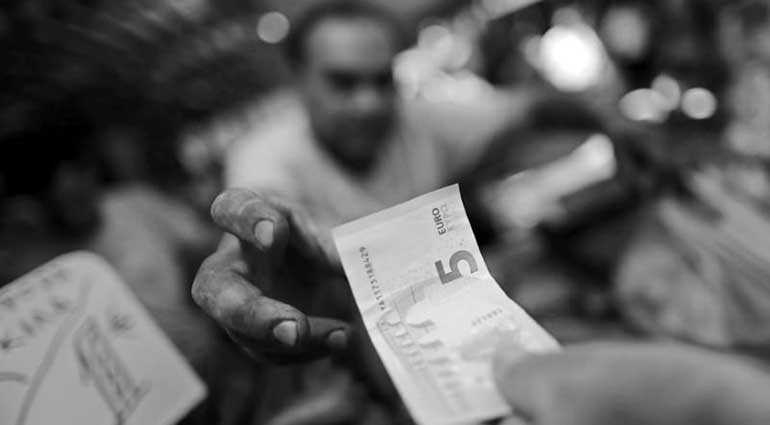Sunday Mar 09, 2025
Sunday Mar 09, 2025
Saturday, 11 August 2018 01:43 - - {{hitsCtrl.values.hits}}

Shanghai (Reuters): Worries over the plunging Turkish lira and Russian ruble pulled the euro lower on Friday and rippled through riskier assets worldwide, sending stock markets lower and buoying safe haven assets such as US Treasuries.
The euro fell to its lowest level since July 2017 and the dollar rallied as Washington piled pressure on Ankara and Moscow. The lira went into free-fall, sinking more than 10% to all-time lows.
European stocks looked set to start well in the red, following losses in Asia and US futures.
Spreadbetters indicated London’s FTSE was set to open 4 points lower at 7,738, Frankfurt’s DAX 17 points lower at 12,660 and Paris’ CAC 11 points down at 5,491.
US S&P mini-futures were down 0.4%, after modest losses on Wall Street overnight.
MSCI’s broadest index of Asia-Pacific shares outside Japan was down 1.1%, trimming its gains for the week to 0.6%.
The Nikkei stock index fell 1.3% as the yen firmed and investors fretted over trade pressure from Washington, overshadowing data which showed Japan’s economy expanded faster-than-expected in the second quarter.
Worries over the escalating Sino-US trade conflict continued to drag on shares in China, with the Shanghai Composite index down 0.4%.
The tech-heavy ChiNext Composite index trimmed its early gains, but was still 0.2% higher in afternoon trade, extending Thursday’s strong gains.
Josh Sheng, chief investment officer at Shanghai Tongshengtonghui Asset Management, said that a late rally in tech shares this week reflected moves by Beijing to boost local firms, such as revamping a government leadership group to focus on supporting homegrown technology.
“The market in China is ‘risk on’ thanks to government support policies and rising infrastructure investment. I am optimistic about the A-share market for the rest of 2018,” he said.
The Shanghai composite has gained 1.5% this week, while the CSI300 is up 2.1%. Both indexes posted heavy losses last week.
Lira, ruble rout
Turmoil in the lira and ruble and intensifying global trade tensions pushed the dollar to 13-month highs.
The dollar index, which measures the greenback’s strength against a group of six major currencies, breached the 96 level, taking it to its highest level since 14 July 2017.
The euro dropped 0.6% to $1.1456 after earlier falling as low as $1.1436, a 13-month low. The dollar was 0.1% lower at 110.97 yen.
Turkey’s lira plumbed new depths against the dollar, with a meeting between a Turkish delegation and US officials in Washington yielding no apparent solution to a diplomatic rift over the detention in Turkey of a US pastor.
Deepening investor concerns about Turkey’s authoritarian trajectory under President Tayyip Erdogan and the economic fallout have also weighed on the currency.
By 0617 GMT, the lira was at 6.4, having fallen as low as 6.4915 earlier. The currency has lost more than one third of its value this year.
The ruble weakened to 66.86 to the dollar. Overnight it had retreated to its lowest since November 2016 on threats of new US sanctions, weakening beyond the psychologically important 65-per-dollar threshold.
“Other EM currencies have held their ground against the dollar, having generally been weakening previously,” said analysts at Capital Economics.
“In most cases though, we suspect that this resilience will prove temporary,” they said, highlighting expectations of rising US interest rates and worries over growing US protectionism.
US Treasury yields fell as investors sought safety in bonds, with the yield on benchmark 10-year Treasury notes at 2.9076% compared with 2.935% at its US close.
Investors were awaiting the release of the US consumer price inflation (CPI) report for July (1230 GMT) for possible clues on interest rates and any signs of an impact from new tariffs. The data is expected to show inflation likely increased 0.2%, after rising 0.1% in June.
Discover Kapruka, the leading online shopping platform in Sri Lanka, where you can conveniently send Gifts and Flowers to your loved ones for any event including Valentine ’s Day. Explore a wide range of popular Shopping Categories on Kapruka, including Toys, Groceries, Electronics, Birthday Cakes, Fruits, Chocolates, Flower Bouquets, Clothing, Watches, Lingerie, Gift Sets and Jewellery. Also if you’re interested in selling with Kapruka, Partner Central by Kapruka is the best solution to start with. Moreover, through Kapruka Global Shop, you can also enjoy the convenience of purchasing products from renowned platforms like Amazon and eBay and have them delivered to Sri Lanka.
Discover Kapruka, the leading online shopping platform in Sri Lanka, where you can conveniently send Gifts and Flowers to your loved ones for any event including Valentine ’s Day. Explore a wide range of popular Shopping Categories on Kapruka, including Toys, Groceries, Electronics, Birthday Cakes, Fruits, Chocolates, Flower Bouquets, Clothing, Watches, Lingerie, Gift Sets and Jewellery. Also if you’re interested in selling with Kapruka, Partner Central by Kapruka is the best solution to start with. Moreover, through Kapruka Global Shop, you can also enjoy the convenience of purchasing products from renowned platforms like Amazon and eBay and have them delivered to Sri Lanka.